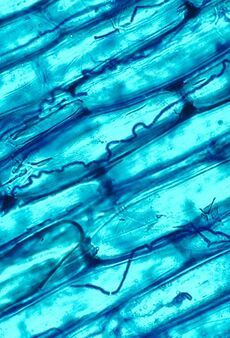Biology:Epichloë coenophiala
| Epichloë coenophiala | |
|---|---|

| |
| Scientific classification | |
| Domain: | Eukaryota |
| Kingdom: | Fungi |
| Division: | Ascomycota |
| Class: | Sordariomycetes |
| Order: | Hypocreales |
| Family: | Clavicipitaceae |
| Genus: | Epichloë |
| Species: | E. coenophiala
|
| Binomial name | |
| Epichloë coenophiala (Morgan-Jones & W.Gams) C.W. Bacon & Schardl
| |
| Synonyms | |
| |
Epichloë coenophiala is a systemic and seed-transmissible endophyte of tall fescue, a grass endemic to Eurasia and North Africa, but widely naturalized in North America, Australia and New Zealand. The endophyte has been identified as the cause of the "fescue toxicosis" syndrome sometimes suffered by livestock that graze the infected grass. Possible symptoms include poor weight gain, elevated body temperature, reduced conception rates, agalactia, rough hair coat, fat necrosis, loss of switch and ear tips, and lameness or dry gangrene of the feet. Because of the resemblance to symptoms of ergotism in humans, the most likely agents responsible for fescue toxicosis are thought to be the ergot alkaloids, principally ergovaline produced by E. coenophiala.[1]
Continued popularity of tall fescue with this endophyte, despite episodic livestock toxicosis, is attributable to the exceptional productivity and stress tolerance of the grass in pastures and hay fields. The endophyte produces two classes of alkaloids, loline alkaloids and the pyrrolopyrazine, peramine, which are insecticidal and insect deterrent, respectively, and presence of the fungus increases drought tolerance, nitrogen utilization, phosphate acquisition, and resistance to nematodes.[2][3] Recently, natural strains of E. coenophiala with little or no ergot alkaloid production have been introduced into tall fescue for new cultivar development. These strains are apparently not toxic to livestock,[4] and also provide some, but not necessarily all, of the benefits attributable to the "common toxic" strains in the older tall fescue cultivars.[3][4]
Epichloë coniophiala was originally described as an Acremonium species and later moved to the anamorphic form genus Neotyphodium. Today, it is classified in Epichloë.[5] Molecular phylogenetic analysis indicates that E. coenophiala is an interspecific hybrid with three ancestors: E. festucae, a strain from the Epichloë typhina complex (from Poa nemoralis) and a third, undescribed or extinct species similar to the Lolium associated clade of Epichloë baconii that also contributed a genome to the hybrid endophyte E. occultans, among others.[6][7]
References
- ↑ "Occurrence of peptide and clavine ergot alkaloids in tall fescue grass". Science 232 (4749): 487–489. 1986. doi:10.1126/science.3008328. PMID 3008328.
- ↑ "Adaptations of endophyte-infected cool-season grasses to environmental stresses: Mechanisms of drought and mineral stress tolerance". Crop Sci 40 (4): 923–940. 2000. doi:10.2135/cropsci2000.404923x.
- ↑ 3.0 3.1 "Response of Pratylenchus spp. in tall fescue infected with different strains of the fungal endophyte Neotyphodium coenophialum". Nematology 7: 105–110. 2005. doi:10.1163/1568541054192216.
- ↑ 4.0 4.1 "Use of nonergot alkaloid-producing endophytes for alleviating tall fescue toxicosis in stocker cattle". Journal of Animal Science 81 (11): 2856–2868. 2003. doi:10.2527/2003.81112856x. PMID 14601890.
- ↑ Leuchtmann, A.; Bacon, C. W.; Schardl, C. L.; White, J. F.; Tadych, M. (2014). "Nomenclatural realignment of Neotyphodium species with genus Epichloë". Mycologia 106 (2): 202–215. doi:10.3852/13-251. ISSN 0027-5514. PMID 24459125. http://www.epa.govt.nz/search-databases/HSNO%20Application%20Register%20Documents/APP201774_Leuchtmann%20et%20al%202014.pdf. Retrieved 2016-02-28.
- ↑ "Evolutionary diversification of fungal endophytes of tall fescue grass by hybridization with Epichloë species". PNAS 91 (7): 2542–2546. 1994. doi:10.1073/pnas.91.7.2542. PMID 8172623.
- ↑ "Prevalence of interspecific hybrids amongst asexual fungal endophytes of grasses". Molecular Ecology 13 (6): 1455–1467. 2004. doi:10.1111/j.1365-294X.2004.02138.x. PMID 15140090.
Wikidata ☰ Q2713632 entry
 |

